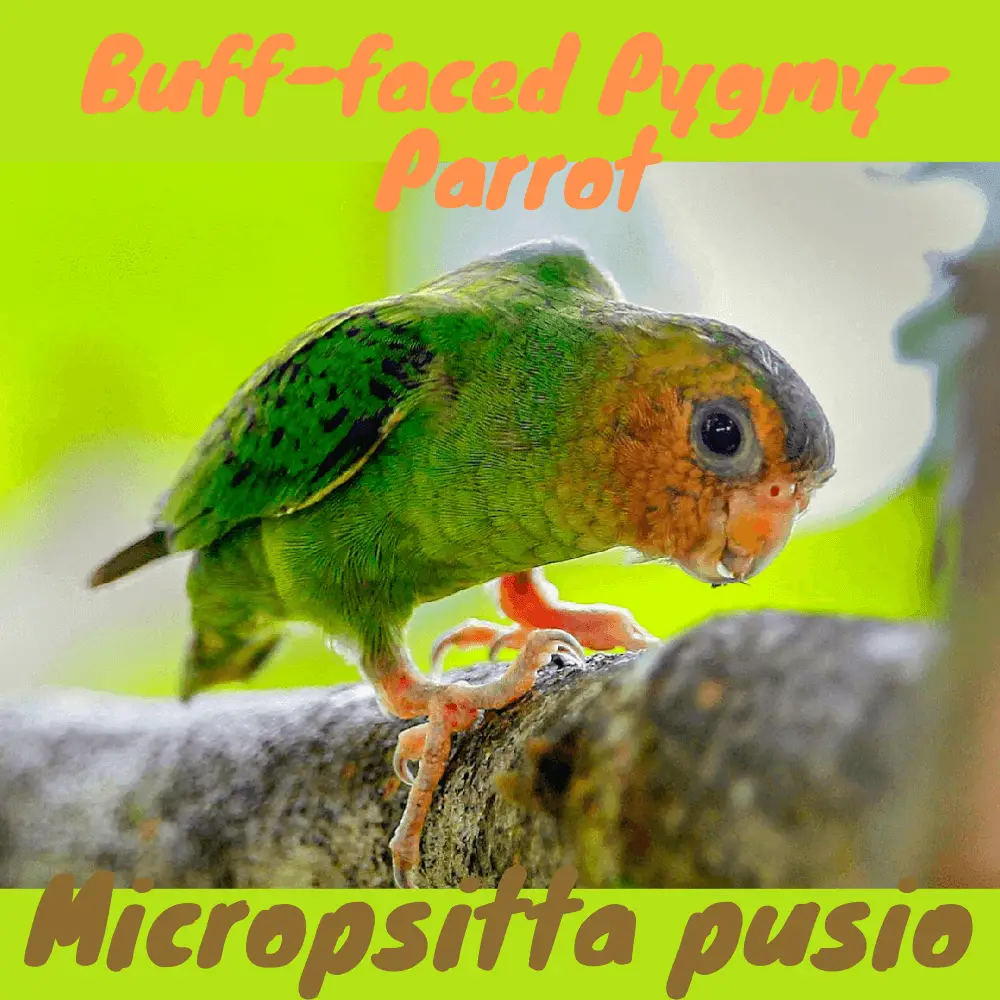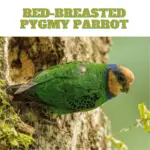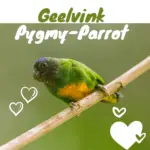
Buff-faced Pygmy-Parrot (Micropsitta pusio) 8 cm; 10–15 g. Generally green, more yellowish on underparts; forehead and face buff-ochre, sometimes with yellowish superciliary stripe;
central crown to nape deep blue; back and wings green, with black spotting on median wing-coverts; under tail-coverts yellow; tail blue centrally, black laterally with small yellow spots at tips.
The Female parrot has a paler face and crown. Immature has a green crown. Race harterti greener below, throat washed blue; stresemanni like harterti but yellower below; beccarii darker, with a duller brown face
Micropsitta pusio Scientific name definitions
- LC Least Concern
- Names (16)
- Subspecies (4)
Systematics History
Editor’s Note: This article requires further editing work to merge existing content into the appropriate Subspecies sections. Please bear with us while this update takes place.
Forms a species group with M. keiensis and M. geelvinkiana. All races are very similar and validity has been questioned, as distinguishing characters are not obvious and the provenance of some material is currently in doubt;
species may be better considered monotypic. Proposed race salvadorii included in beccarii, and pusilla innominate. Four subspecies are tentatively recognized.
Subspecies

Buff-faced Pygmy-Parrot
SUBSPECIES
Micropsitta pusio beccarii Scientific name definitions
Distribution
N New Guinea from W Geelvink Bay E to Huon Bay, and islands of Manam, Karkar, Bagabag, Tolokiwa, Sakar and Umboi.
SUBSPECIES
Micropsitta pusio pusio Scientific name definitions
Distribution
E New Guinea and Bismarck Archipelago (New Britain, Lolobau, Watom, Duke of York).
SUBSPECIES
Micropsitta pusio harterti Scientific name definitions
Distribution
Fergusson I (in D’Entrecasteaux Is).
SUBSPECIES
Micropsitta pusio stresemanni Scientific name definitions
Distribution
Misima I and Tagula I (Louisiade Archipelago).
Distribution
Editor’s Note: Additional distribution information for this taxon can be found in the ‘Subspecies’ article above. In the future, we will develop a range-wide distribution article.
Habitat
Lowland and floodplain gallery forest, tall secondary growth and trees in clearings, sometimes dense savanna and coconut stands, up to 800 m, although only common up to 400 m.
Movement
Wandering groups were noted in extreme E of range, but whether there is true nomadism or birds simply range over large home ranges over several weeks is not known.
Diet and Foraging
Lichen, bark fungus, and probably termites; insect remains tiny black seeds, yellow fruit flesh, and flowers in stomachs.
Sounds and Vocal Behavior
Calls include high-pitched short notes such as “tsit” or “tsee”. Also short phrases of 2–4 different notes, e.g. “tsee-tsi-tsit”.
Breeding
Sept-May. Nest in a hole excavated in arboreal termitarium, in one case that of Microcerotermes biroi about 2 m above ground on the trunk of a small tree in secondary forest. Eggs 2–3, size 16·2 mm × 14·3 mm (n = 1).
Conservation Status

Buff-faced Pygmy-Parrot
Conservation status on BirdlifeLC Least Concern
Not globally threatened. CITES II. Very uncommon or local on Sepik R, but common in Owen Stanley Range foothills, SE Papua New Guinea, where density is estimated at 20 birds/km².
Common, Bismarcks and Bagabag. Abundance may be underestimated owing to unobtrusive habits, e.g. infrequently seen near Port Moresby yet calls suggest it to be the most abundant parrot in the area.




















